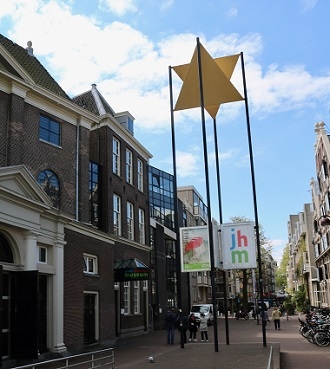The Dutch and The Holocaust
A visit to Jewish Cultural Quarter in Amsterdam requires a suspension of preconceived notions. Unlike the quaint houses and picturesque canals of its environs, the Jodenbuurt, as the Jewish district is known, is largely modern. That's because most of the buildings were razed after World War II, a result of plundering of abandoned Jewish properties by Dutch inhabitants.
Another misconception is that there is a large Sephardic community. While the centerpiece of the Jewish district is the ancient Portuguese Synagogue, built in 1675, there are also four Ashkenazi synagogues, all in one complex, which today form the Jewish History Museum of Amsterdam.
Ashkenazi Jews, who arrived in Amsterdam during the Middle Ages, today comprise most of the 30,000 Jews who live in the city. Almost no Jews live in the ancient Jewish Quarter.
The last, and perhaps most important misconception, is of Dutch heroism and tolerance, forged from the historical fact of Amsterdam as a city that welcomed Jews fleeing Spain and Portugal after the Inquisition, and from the narrative spun from the Anne Frank diaries, that the Dutch were heroic during the Holocaust.
Amsterdam did welcome Jews fleeing persecution, but mainly to boost its trading empire. Jews however, were not allowed in the artisanal guilds or professions, which meant that the large majority of the community was poor.
About 80% of the Netherlands' pre-war Jewish population of 156,000 some 130,000 people, were killed in the Holocaust. That is the highest rate in Western Europe.
For decades after the war, little attention was paid to the massacre of Dutch Jews, with the predominant narrative drawn from the inspiring story of Anne Frank. That has changed in recent years.
A new Holocaust museum was opened last year in a former theater on Plantage Middenlaan Street. There are also plans to build a Holocaust Memorial in the Jodenbuurt.
Most visitors begin their tour of the Jewish district at the Portuguese Synagogue, one of the most beautiful synagogues in the world which has been in continuous use since 1672.
Known as the "Snoga", the Sephardic synagogue, with its vast interior, exquisite woodwork and sand floors is a breathtaking work of architecture. Inside its walls is the Etz Haim Library, one of the oldest compilations of Jewish books in the world.
Across the street is the Jewish Museum. There, along with the renovated Ashkenazi synagogues, is a visual narration of the history of Jews in Amsterdam, from the arrival of Spanish Jews and Marranos in the 17th century, to the influx of Eastern European Jewry, the Holocaust, and contemporary Jewish life.
Among the highlights of the museum are exhibitions about the famed Amsterdam printing and publishing works.
During the 18th century, Amsterdam was the center of publishing in the Ashkenazi world, producing and disseminating magnificently typeset books and manuscripts.
The museum also has a trove of religious and secular artifacts of its Jewish history. Not to be missed is the trial and excommunication of the Jewish philosopher Spinoza from the Jewish community for his writings, giving precedence to rational, empirical works over biblical and religious sources.
Jewish life in Amsterdam today is located mostly outside the old Jewish district.
The rise of anti-Semitism and hostility toward immigrants is of concern to the Jewish leadership.
Ronny Naftaniel, former head of CIDI, the main Jewish advocacy organization, notes that there have not been any violent attacks against Jews in Amsterdam. "We feel comfortable as Jews in Amsterdam, but remain vigilant for all signs of hatred and intolerance," says Naftaniel.
Harry D. Wall is the producer of Jewish Discoveries, an online travelogue of Jewish communities and culture worldwide. www.JewishDiscoveries.com











Comments